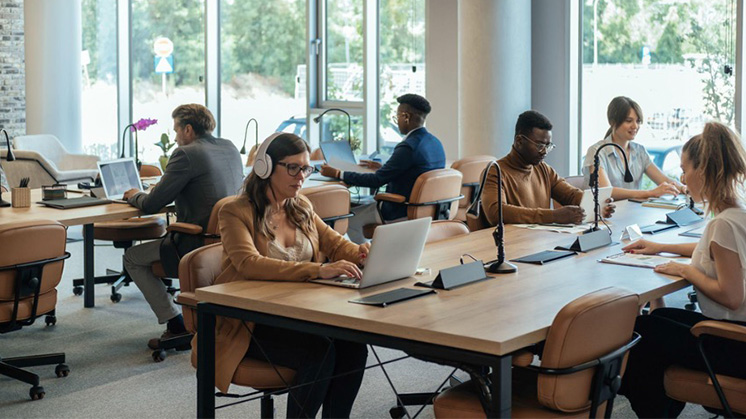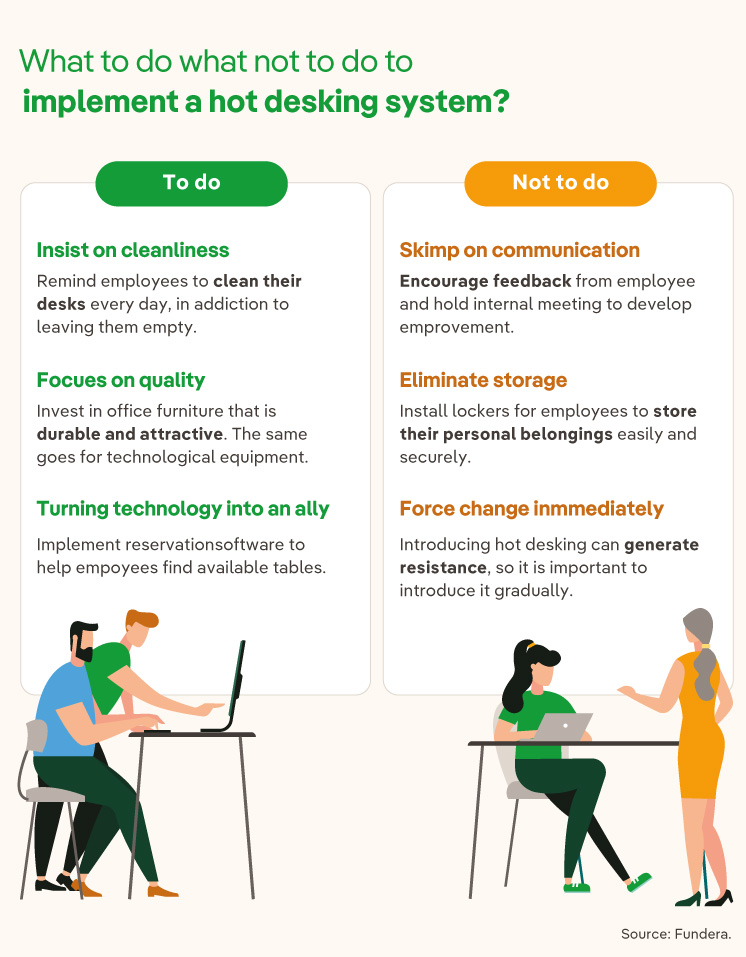Hot desking
'Hot desking', what is it and why is it fashionable?
In recent years, due to the evolution of the way we work and the constant change in the business world, many companies have rethought their office model. Among the most widely adopted options is hot desking, which consists of creating shared and on-demand workspaces that are more flexible, more economical and more oriented towards fostering collaboration among employees.

Our working environment has undergone a profound transformation in recent years, and much of this change has been driven by digital advances and the use of information technology. The way we work on a day-to-day basis and how office space is organised continues to evolve into new dynamics that are unlikely to return to the way we knew them in the past.
In this new scenario, many companies have been forced to accelerate their transformation processes and adapt to the new times. Teleworking and coworking, examples of the new work performance formulas, have gone from being the exception to the norm, forcing professionals to adapt to this reality by leaps and bounds. Below, we explain in detail another of these new models: hot desking.
What is hot desking
The term hot desking defines a renovation of the workspace whose main characteristic is that the employee no longer has a fixed desk, i.e. he or she can move to a different one every day. The objectives are to create a more flexible and collaborative environment and to encourage more fluid communication. In recent times, this practice is becoming a trend in some companies -it must be borne in mind that each company has its own idiosyncrasies and not all of them can adopt this model -.
The origin of the term hot desking can be found in another term: hot racking. The latter refers to a practice in the US Navy whereby Marines share bunks according to the organisation of their shifts. In fact, the idea of hot racking comes from the fact that when the Marines go to bed, the bed remains warm when the previous occupant has just left it. This method was adopted because of the limited space on the ships.
In its own way, hot desking also seeks to optimise space and does so by sharing desks according to availability. Let's take a look at the situation. We arrive at the office on Monday at 8am and occupy a free hot desk that we have previously booked via an app. The next day, it is likely that this desk will be occupied and we will have to book another one to carry out the day's work.
Characteristics of hot desking
The characteristics of this model can be summarised in the following points:
- No fixed desk. Nobody is assigned a specific desk and workers sit in different spots in the office on different days. However, there are employee lockers where they can store their personal belongings.
- Efficient use of space: The fact you do not have your own desk and combine time in the office with remote work at home makes it possible to better organise the office and set up more meeting spaces.
- Smoother communication. One beneficial aspect of this method is that employees from different areas end up in one area, which improves interpersonal relationships.

Advantages and disadvantages of hot desking
Hot desking has numerous advantages:
![]() Encourages collaboration
Encourages collaboration
Its rotating nature helps to meet new people on a daily basis and to promote networking, as well as generating an atmosphere that strengthens teamwork.
![]() It saves costs
It saves costs
By optimising space, never having 100 % of the staff, and installing resources shared by all employees, office costs are reduced.
![]() It encourages environmental diversity
It encourages environmental diversity
The possibility of choosing a desk allows you to enjoy different work environments depending on what you are looking for: inspiration, motivation, concentration, etc.
![]() It improves individual organisation
It improves individual organisation
Without a fixed desk, workers have to collect their belongings daily, so that the next person to use it finds it empty and clean. This improves productivity.
Despite its many advantages, like all models, hot desking also has its disadvantages. On the one hand, it creates a less welcoming working environment - not having your own desk or the same colleagues always at your side can lead to uprooting - and, on the other hand, a loss of motivation - lacking an emotional connection to your workplace can affect your mood and even reduce your creativity -.
To avoid these drawbacks, it is essential that the company leads a proper change management and Fundera, an American company that helps companies make the best business decisions, proposes the following initiatives:
- Focus on employees' habits to rationalise the schedule and agree on an implementation plan.
- Consider employee preferences and create a section in the office for those who need their own workspace.
- Leverage technology to make it easier and faster to book hot desks, usually through a mobile app.
- Be transparent with employees in order to involve them in the new company culture from minute one.
- Share with employees a list of guidelines and best practice tips to help them adapt to the new model.
- Encourage communication to get feedback from employees, e.g. through anonymous surveys.




